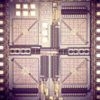-
Posts
12,026 -
Joined
-
Last visited
-
Days Won
13
Reputation Activity
-
 audioguru got a reaction from EJE in 0-30 Vdc Stabilized Power Supply
audioguru got a reaction from EJE in 0-30 Vdc Stabilized Power Supply
I use copper wire, not rice wire. They put rice in everything they make, especially batteries.
-
 audioguru got a reaction from spur in 0-30V Stabilized Power Supply
audioguru got a reaction from spur in 0-30V Stabilized Power Supply
Transistors are all different. There are good ones and there are poor ones. The worst (but still passing) 2N3055 transistor has a collector to emitter leakage current of 0.7mA but a good one has much less.
The collector-base leakage current is much less (a maximum of only 3.5uA at 25 degrees C) then it is amplified maybe 200 times by the current gain of the transistor so the 1k resistor from base to emitter completely kills the leakage current.
R16 in our project is the "R" for the output transistors so they do not have leakage current. If R16 is missing then the output transistors will amplify their collector-base leakage current which will cause them to turn on. -
 audioguru got a reaction from spur in 0-30V Stabilized Power Supply
audioguru got a reaction from spur in 0-30V Stabilized Power Supply
The collector-base junction of a transistor has a small leakage current that increases when the temperature increases. The current gain of a transistor amplifies the resulting base current which turns on the transistor. R16 shunts the collector-base leakage current away from the base.
Of course not, the collector-base leakage current causes Q4 to turn on.
Leakage current and dielectric absorption in C7 causes the output voltage to rise when the load current is zero or is low.
The datasheet for a 2N3055 transistor shows that its maximum collector to emitter leakage current is 0.7mA when it has a Vce of 30V, it is at 25 degrees C and it has no base current with its base not connected. -
 audioguru got a reaction from Ishwor in 0-30 Vdc Stabilized Power Supply
audioguru got a reaction from Ishwor in 0-30 Vdc Stabilized Power Supply
The original circuit should work fine up to 15V at 1A if you replace the old opamps with the newer higher voltage ones. You probably should recalculate the resistors that set the maximum voltage and current outputs. If the Chinese kit uses the transistor that shorts the opamp output when the power is turned off then the resistors that feed the transistor need to be recalculated for the reduced voltage.
I have used perforated stripboard for many projects including very complicated ones. The copper strips are cut to length with a drill-bit and become almost half the wiring of a pcb. The parts and a few short jumper wires become the remainder of the wiring. Only one wire is in each hole so changing a part is easy like on a pcb.
-
 audioguru got a reaction from frisil in 0-30V 0-3A Latest Data
audioguru got a reaction from frisil in 0-30V 0-3A Latest Data
The 24VAC transformer probably produces 25VAC with a light load on the project. Then its rectified and filtered output is +34V and -5.6V which power the opamps. At times the voltages are higher. Your transformer will be overloaded if its power rating is 105VA or less (24V at 4.4A)..
The old TL081 opamps have an absolute maximum allowed supply of a total of only 36V so they will not last long. Replace the opamps with TLE2141 opamps that have a maximum allowed supply of 44V.
Many of the resistors and the driver transistor in the original project are overloaded. Upgrade them. The main filter capacitor C1 value is much too low, upgrade it.
-
 audioguru got a reaction from Whizard in 0-30 volt stailized power supply
audioguru got a reaction from Whizard in 0-30 volt stailized power supply
If the transformer is rated at 24VAC/2A then it provides a maximum power of 24V x 2A= 48VA.
But if the output is 30V at 2.0A then the load uses 30V x 2A= 60VA plus heating power. The peak of 24VAC is 40V which feeds the bridge rectifier which charges the main filter capacitor to the peak voltage minus the rectifier forward voltage. So then the transformer must produce 40V at 2.0A= 80VA which is much more than the overloaded 48VA. 80VA/24V= 3.33A, not 2A.
For a regulated output of 30.0VDC at 3A then I recommended using a transformer rated at 28VAC/4.3A.
For an output current of 3A then you must look at how much heat is produced by the single output transistor which is why I recommended using two output transistors to share the heat.
Edited with strike-throughs.
-
 audioguru got a reaction from Tornado17 in 0-30V Stabilized Power Supply
audioguru got a reaction from Tornado17 in 0-30V Stabilized Power Supply
Why do you show an LT1038? it is obsolete and is not made anymore.
It is impossible for it to dissipate 32V x 10A= 320W. Its datasheet shows that with a huge heatsink with fan or with liquid nitrogen for cooling it can dissipate only 120W. Its control circuit gives 10A only when its input to output is a few volts and cuts the max current to 2.5A when the input to output is 30V.
-
 audioguru got a reaction from Aokane in LED panel .
audioguru got a reaction from Aokane in LED panel .
I cannot see which connects to what. Can you provide a schematic?
-
 audioguru got a reaction from jonythunder in 0-30 Vdc Stabilized Power Supply
audioguru got a reaction from jonythunder in 0-30 Vdc Stabilized Power Supply
The original circuit should work fine up to 15V at 1A if you replace the old opamps with the newer higher voltage ones. You probably should recalculate the resistors that set the maximum voltage and current outputs. If the Chinese kit uses the transistor that shorts the opamp output when the power is turned off then the resistors that feed the transistor need to be recalculated for the reduced voltage.
I have used perforated stripboard for many projects including very complicated ones. The copper strips are cut to length with a drill-bit and become almost half the wiring of a pcb. The parts and a few short jumper wires become the remainder of the wiring. Only one wire is in each hole so changing a part is easy like on a pcb.
-
 audioguru got a reaction from Mate_Well in 0-30 Vdc Stabilized Power Supply
audioguru got a reaction from Mate_Well in 0-30 Vdc Stabilized Power Supply
Did you know that Chinese companies (ebay, Aliexpress, Banggood, Amazon and others) have copied the original defective Greek kit and used the wrong opamps and resistors that burn up? Their kits of the original project are very cheap. They use some Oriental transistors instead of the original ones.
-
 audioguru got a reaction from Mate_Well in 0-30 Vdc Stabilized Power Supply
audioguru got a reaction from Mate_Well in 0-30 Vdc Stabilized Power Supply
The original project used a 24VAC transformer and TL081 opamps that have a maximum allowed supply of 36V. Since the project was not able to produce 30VDC at 3A because the supply voltage was too low, I changed the transformer to 28VAC and changed the opamps to TLE2141 that have a maximum allowed supply of 44VDC.
Please post a video of your TLE2141 opamps blowing up if you power them from the 66VDC produced from rectifying the 48VAC from your wrong transformer. Or just parallel the two 24VAC secondaries which produces a rectified 32VDC so that the maximum regulated output from the project will be about 25VDC at 3A.
The TLE2141 U2 gets warm, not hot because its output current is fairly low since it drives the driver transistor Q2 that drives the output transistors to 3A.
-
 audioguru got a reaction from Mate_Well in 0-30 Vdc Stabilized Power Supply
audioguru got a reaction from Mate_Well in 0-30 Vdc Stabilized Power Supply
One 2N3055 transistor overheats in the original circuit that used a 24VAC transformer and produces 25VDC at 3A. Therefore I used higher voltage opamps, a 28V 4.2A transformer, a more modern driver transistor Q2 that can be cooled well and two 2N3055 transistors to share the heat on a very large heatsink. Some people added a fan and a smaller heatsink instead of a huge heatsink.
If you connect the two 24V windings of your transformer in series and use the centertap as 0V then its output voltage will be 24VAC x 1.414= 34V minus the 1V for the two rectifiers then the supply voltage will be too low because the circuit needs a 28VAC transformer.
Your transformer voltage is too high so it cannot be used for this project. Or you could parallel the two 24VAC windings or with the centertap as above then the maximum regulated output voltage will be 25VDC at 3A.
-
 audioguru got a reaction from Mate_Well in 0-30 Vdc Stabilized Power Supply
audioguru got a reaction from Mate_Well in 0-30 Vdc Stabilized Power Supply
The 24VAC transformer has an output voltage too low for this power supply to produce 30VDC at 3A. The regulation will fail and there will be lots of ripple in the output at and above about 25V at 3A. I recommended a 28VAC or 30VAC transformer and higher voltage opamps years ago.
For an output up to 5A then the transformer max output current should be 7A or more, the main filter capacitor C1 value should be about 17000uF or more, there should be 3 output transistors each with its own emitter resistor, a larger heatsink for the output transistors and change the value of R7 from 0.47 ohms to 0.27 ohms.
I finished making improvements on this project in July, 2014 but others have made more changes.
-
 audioguru got a reaction from Mate_Well in 0-30 Vdc Stabilized Power Supply
audioguru got a reaction from Mate_Well in 0-30 Vdc Stabilized Power Supply
The TIP31 is 83 times slower than the BD139 that I recommend that has almost the same speed as the original 2N2219 that got too hot as Q2. Then the TIP31 will probably cause oscillation.
-
 audioguru got a reaction from soldertools1 in Power supply
audioguru got a reaction from soldertools1 in Power supply
You forgot to say if the 10V output from your power supply must be AC or DC. You also forgot to say if the input is AC or DC and its voltage and frequency.
Did you know that the output power from your power supply will be 10V x 1000A= 10000 Watts? Where will it come from? What will it be used for?
-
 audioguru got a reaction from HaddyS in High Voltage low amperage
audioguru got a reaction from HaddyS in High Voltage low amperage
10,000V at 0.02A is 200W which is a lot of power for a little power supply.
-
 audioguru got a reaction from HaddyS in battery level indicator
audioguru got a reaction from HaddyS in battery level indicator
The LM3914 in a DIP case is not made anymore. Buy them before they are all gone.
-
 audioguru got a reaction from HaddyS in 0-30 Vdc Stabilized Power Supply
audioguru got a reaction from HaddyS in 0-30 Vdc Stabilized Power Supply
The original defective circuit had many overloaded parts that will blow up. The improved version fixes it.
Opamp U3 senses the output current in R7 and reduces the output voltage and output current to match the current set with P2. The maximum output current is 3.0A in the improved circuit and the two output transistors have a total maximum current rating of 30A so they will not blow up with only 3.0A.
-
 audioguru got a reaction from PhillipGok in Surround Sound for car audio
audioguru got a reaction from PhillipGok in Surround Sound for car audio
The Hafler opamp circuit should do what you want.
The New Japan Radio IC datasheet doesn't explain what it does. It has graphs showing bass-frequencies-only, some phase-shift amounts and its block diagram shows a subtraction circuit for both channels but doesn't show what is subtracted.
-
 audioguru got a reaction from electron234 in 0-30 Vdc Stabilized Power Supply
audioguru got a reaction from electron234 in 0-30 Vdc Stabilized Power Supply
I use copper wire, not rice wire. They put rice in everything they make, especially batteries.
-
 audioguru got a reaction from soldertools1 in acid_circuit
audioguru got a reaction from soldertools1 in acid_circuit
Why are you using an old fashioned vented lead-acid battery? Most circuits today are powered by rechargeable Ni-MH or Lithium batteries that have no acid.
-
 audioguru got a reaction from electron234 in A modern day 0 - 30V, 0 - 3A Linear Power Supply?
audioguru got a reaction from electron234 in A modern day 0 - 30V, 0 - 3A Linear Power Supply?
The ebay kit that is a copy of the original faulty Greek power supply on this site is also sold by Banggood and Amazon. Banggood is selling it at a clearance price since they probably had many complaints. They have modified it a little and are selling it again as a kit with a 28V/2A rating and an LCD meter for it.
The very nice looking 30V/10A power supply is extremely cheap. Its ad has no detailed spec's. It does not even say if the voltage and current are regulated.
If something looks to be too good then it probably is not true.
-
 audioguru got a reaction from HaddyS in 0-30 Vdc Stabilized Power Supply
audioguru got a reaction from HaddyS in 0-30 Vdc Stabilized Power Supply
Since it was years ago I do not remember which page of which thread has version 6 or 7. I have the schematic and parts list of version 6 here:
-
 audioguru got a reaction from Jordan&tiffany in Electronic Gun !!!!!!!!!
audioguru got a reaction from Jordan&tiffany in Electronic Gun !!!!!!!!!
Hi Shantanu,
Electrolytic capacitors have a vent on top to slowly release gasses that build up when the capacitor is connected with backwards polarity then has a high current.
With a very high current, the vent cannot release the gasses slowly so the capacitor explodes.
A 9V battery cannot provide a very high current. Maybe a battery made with series-connected AA Ni-Cad or Ni-MH cells would provide enough current for a backwards electrolytic capacitor to explode. Bad-smelling "fluff" comes out.
-
 audioguru got a reaction from teprojects1 in How to find electronic parts?
audioguru got a reaction from teprojects1 in How to find electronic parts?
I buy electronic parts from Digikey and Newark because they have offices and warehouses in my country and they stock everything.
What can't you find?




